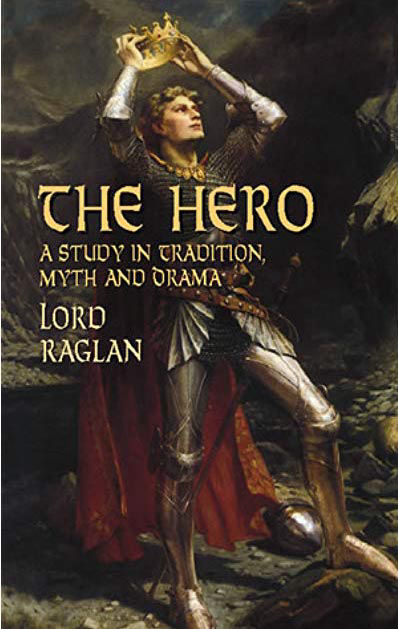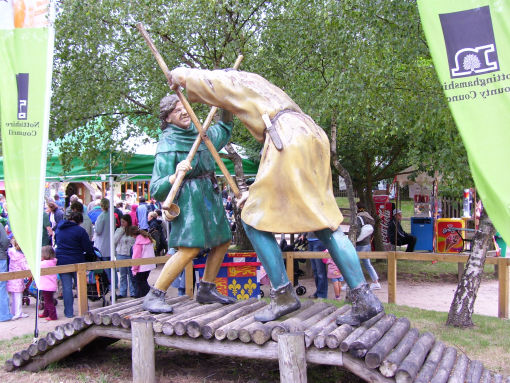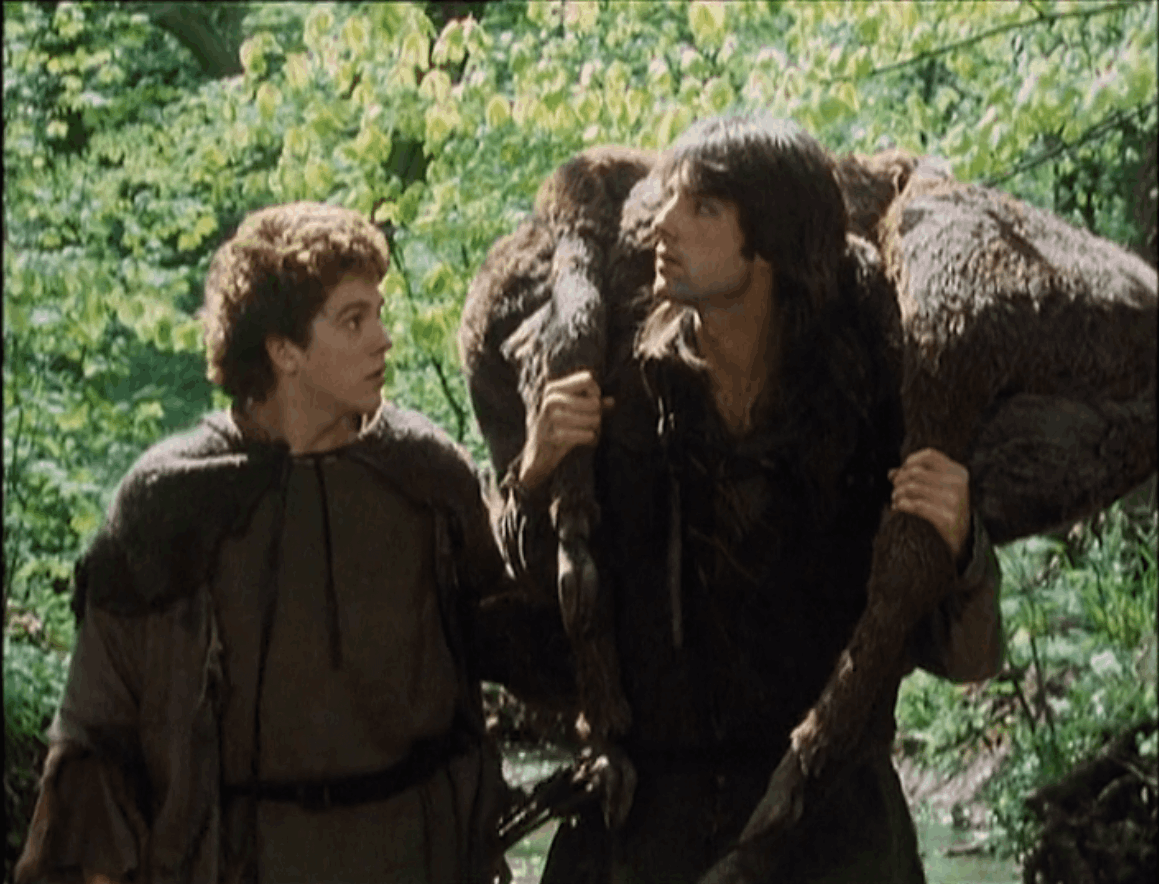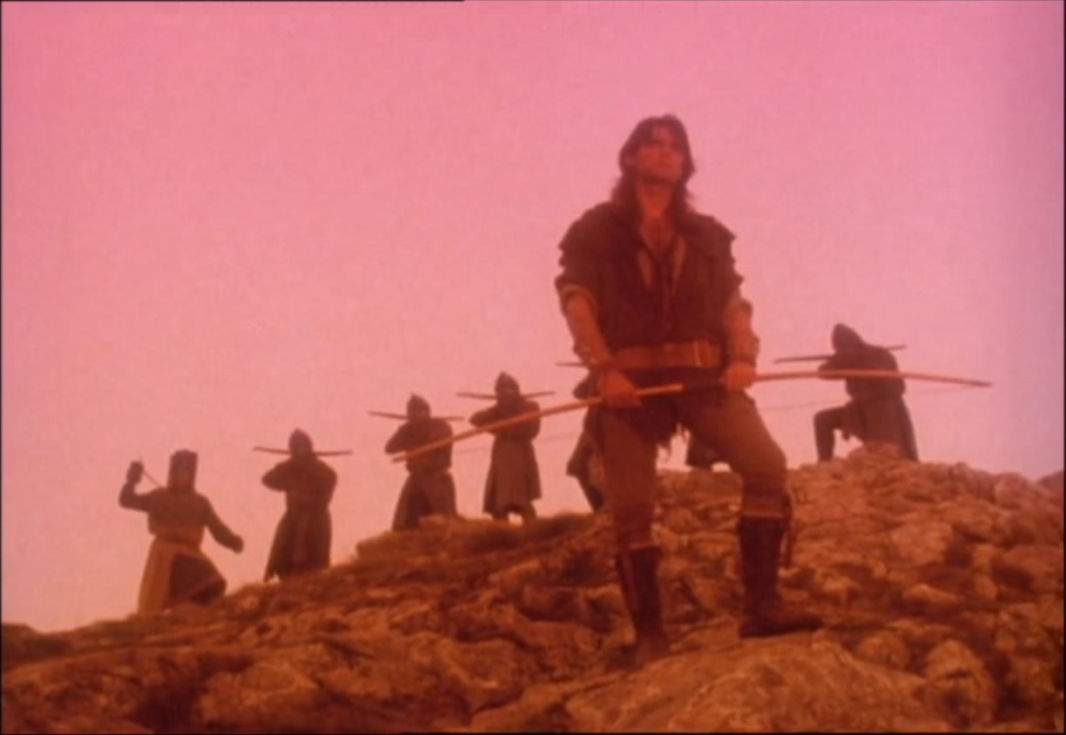
The Hero by Lord Raglan

The Robin Hood Legend
Both film and TV historian Jeffrey Richards and The Hooded Man author Andrew Orton have written about the great similarities between Robin of Sherwood and Star Wars. It is but a small step from “The Powers of Light and Darkness are with you” to “May the Force be with you.” Orton compares the structure of the episode “Robin Hood and the Sorcerer” to Star Wars.
Both Robin of Sherwood’s creator Richard Carpenter and Star Wars’ creator George Lucas admired the works of mythology and folklore scholar Joseph Campbell. Campbell’s best-known work is the 1949 book The Hero with a Thousand Faces which traces the journey common to most heroes what Campbell called (borrowing a term from novelist James Joyce) “the monmyth”. Campbell’s theories also reached a wide audience in the 1988 TV series The Power of Myth – which was shown on the same American PBS stations still rerunning Robin of Sherwood.
But Campbell was far from the first to see patterns in heroic literature. James George Frazer published the first edition of The Golden Bough in 1890 with subsequent revisions in the decades to follow. Frazer’s work is familiar to modern audiences although modern anthropology has questioned his conclusions. Lesser known today is FitzRoy Richard Somerset, 4th Baron Raglan or “Lord Raglan” as he is credited on his 1936 book The Hero, A Study in Tradition, Myth and Drama.
Lord Raglan's book serves to debunk the legends of myth, pedigrees and local traditions. After setting out his general principles, Lord Raglan announces "I shall next take a series of well-known traditional figures and shall show that there is no good reason to believe that any of them had a historical existence." He starts with Robin Hood, laying out the contradictions and absurdities that accrue from six centuries of storytelling. He includes an element that touches upon Robin of Sherwood.
According to another version of the story, Robin was not a Saxon but a Norman nobleman, who was either by birth Earl of Huntingdon, or was so created by Richard I. Anyone who consults a work of reference, however, will see that the earldom of Huntingdon was held from 1185 to 1216 by David of Scotland, brother of King William the Lion.
Richard Carpenter addresses that point by making his second Robin Hood the son of Earl David (played by Michael Craig in "Herne's Son", "Rutterkin" and the "Knights of the Apocalypse" audio drama.)
After debunking the existence of Robin Hood and other heroes, Lord Raglan goes on to suggest that "the stories were accounts not of fact but of ritual -- that is, myths." Collating various heroic legends Raglan suggests a 22-point pattern of the most common incidents in these stories.
(1) The hero’s mother is a royal virgin;
(2) His father is a king, and
(3) Often a near-relative of his mother, but
(4) The circumstances of his conception are unusual, and
(5) He is also reputed to be the son of a god.
(6) At birth, an attempt is made, usually by his father or maternal grandfather, to kill him, but
(7) He is spirited away, and
(8) Reared by foster parents in a far country.
(9) We are told nothing of his childhood years, but
(10) On reaching manhood, he returns or goes to his future kingdom.
(11) After a victory over the king and/or a giant, dragon, or wild beast,
(12) He marries a princess, often daughter of his predecessor, and
(13) Becomes king.
(14) For a time, he reigns uneventfully, and
(15) Prescribes laws, but
(16) Later he loses favour with the gods and/or his subjects.
(17) Is driven from the throne and city, after which
(18) He meets with a mysterious death,
(19) Often at the top of a hill.
(20) His children, if any, do not succeed him.
(21) His body is not buried, but nevertheless
(22) He has one or more holy sepulchres.

The Hero by Lord Raglan

The Robin Hood Legend
Lord Raglan then applies this scale to a dozen heroic figures showing how they conform to this pattern and how the more they conform to this pattern, the less likely it is that they are real. Of course Robin Hood is among the figures he analyzes.
Traces of the Pattern are also to be found in the story of
ROBIN HOOD
His father is a Saxon yeoman, but he is also (5) reputed to be the son of a great noble. We (9) hear nothing of his youth, but on reaching manhood he lives a life of debauchery until compelled to fly (10) to Sherwood, where he (11) gains victories over the Sheriff of Nottingham, (12) marries Maid Marian, the Queen of the May, and (13) becomes King of the May and ruler of the forest. For a long time he reigns, and (15) prescribes the laws of archery, but eventually illness overtakes him, and he (17) has to leave the forest and meets (18) a mysterious death in (19) an upper room. He (20) has no children. The place of his death and burial are (21) variously given, but (22) miracles were performed at his tomb at Kirkley, in Yorkshire.
We can give him him thirteen points.
Now to get to this point, Lord Raglan is taking the legend as a whole -- such as the composite biography assembled by Joseph Ritson in 1795. And it's pretty clear that he is stretching a few points to make them fit, The first storey (second floor for North Americans) window at Kirklees Priory seems a far cry from the hill mentioned on Lord Raglan's scale
I tried running a few other versions through the Raglan scale.
My calculation for Errol Flynn's Robin Hood from The 1938 film The Adventures of Robin Hood:
(9) We no nothing of his childhood years. (10) As an adult, he claims right to guard Sherwood Forest. (11) He goes through various initiation rites, in recruiting followers. (13) Serving as leader of the poor and oppressed, (15) Robin creates codes of conduct. (11) Eventually defeating Prince John and his followers, (13) King Richard makes Robin the Baron of Locksley and Earl of Sherwood (or something like that) and (12) suggests that Robin marry his royal ward Maid Marian.
(9), (10), (11), (15), (13), (12) – Six. (The same as a historical figure, like Alexander the Great.) However, there are multiple insistences of some points. And it doesn't tell the whole story - beginning to death.
Then I looked at a version with more mythic themes - the 1975 TV series The Legend of Robin Hood starring Martin Potter. The 1975 BBC production also had mythic themes including Robin being fostered with his true identity hidden and encountering a “washer at the ford” (as in the Death ballad, although almost never featured elsewhere).
I found instances of 5, 7, 8, 9, 10, 11, 13, 16, 15, 13, 17, 18, 20, 21
14 Points.
And then I looked at Robin of Sherwood.

Putting Robin of Sherwood to the test, not only does it score more points than what Lord Raglanassigned to the general Robin Hood legend, the points it has in common with Raglan's score are closer to his proposed archetype. For example, Robin dies on a literal hill in this version
Robin of Loxley’s father (2) is Ailric, leader of a Saxon rebellion (and in the novelizations also Thane of Loxley). Robin is also (5) said to be “Herne’s Son” – servant of a pagan god/spirit/man-in-deer-costume. When Robin is a small boy (6) an attempt is made to crush the rebellion and burn down Loxley. But (7) Robin is spirited away by his father, and (8) raised at a mill by his foster parents. Beyond this (9) we are told nothing of his childhood and adolescence. But on reaching manhood (10), he goes hunting in Sherwood Forest and returns there after escaping from the castle. (12) After a victory over the Baron de Belleme (and Sir Guy), he marries Lady Marion, a nobleman’s daughter and his “May Queen”, and (13) becomes the “so- called King of Sherwood”. Robin (15) has his band swear to help the poor and oppressed, sets out rules regarding the treatment of prisoners and dispenses justice against outlaws who do not follow his code. Later (16) Robin and his band are rejected by the villagers of Calverton, and (17) is led into an ambush in Wickham and driven out by the Sheriff and his men. Robin (18) meets a mysterious death (19) on top of a hill. He (20) is not succeeded by his children. And while the sheriff claims to have buried Robin’s body, the sheriff (22) refuses to disclose the grave’s location and says the body was on recognizable.
I would give Robin of Loxley seventeen points.
(2), (5), (6), (7), (8), (9), (10), (12), (13) all occur in “Robin Hood and the Sorcerer”. (Robin says “Herne’s Son has claimed his kingdom” in that episode. The sheriff uses the “so-called king of Sherwood” phrase in “Seven Poor Knights from Acre”. Robin refers to “his people” in “The King’s Fool”.) [Ragland’s own interpretation of (2) is flexible since he gives it to Watu Gunung forhaving a father who is a “holy man”.](15) Robin establishes codes in “Robin Hood and the Sorcerer”, describes how they swore on his sword Albion to help the poor and oppressed in “The Swords of Wayland”, refuses to kill prisoners in “Lord of the Trees” and kills outlaws who have “murdered and robbed my people” in“The King’s Fool”.(16) This happens in “Children of Israel”. Similarly some band members temporarily leave in “The King’s Fool” and the villagers of Wickham are forced to betray him in “The Greatest Enemy”.(17), (18), (19), (20) and (22) occur in “The Greatest Enemy”
The second Robin Hood in Robin of Sherwood, Robert of Huntingdon, would score a bit lower than Robin of Loxley. But it would have stretched credulity if Richard Carpenter recycled all the mythic elements he used for the first Robin's youth and fostering, and the show ended prematurely before we could see Robert's marriage or death.
Even if you want to quibble a point, this gives Richard Carpenter's Robin of Loxley a score in line with Raglan's scores for Heracles (17), Llew Llawgyffes (17), Bellerophon (16) and higher scores than Zeus (15), Jason (15), Perseus (11) and Siegfried (11).
There are also elements of Campbell's Monomyth that do not appear on Raglan's scale. For example, both Robins in Robin of Sherwood initially refuse Herne's "call to adventure". "Refusal of the call" is one of stages on Campbell's hero's journey.
But this is not to suggest that Richard Carpenter used Lord Raglan or Joseph Campbell as a mere checklist for plot summaries. A great many stories rate highly on Raglan's scale, but the ones that resonate with audiences (such as Robin of Sherwood and the Harry Potter books and films) imbue their tales with an individual life and energy that rises above a mere formula. What this section does demonstrate though is that Richard Carpenter created a version of the Robin Hood legend that was more consciously mythic than the norm.

Contact Us